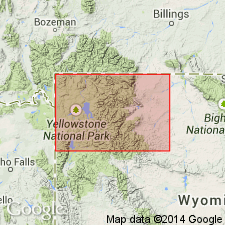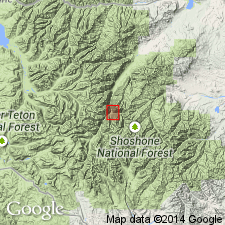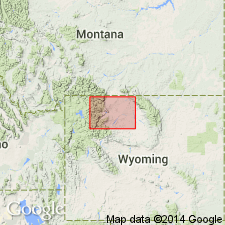
- Usage in publication:
-
- Needle Mountain Granodiorite
- Modifications:
-
- First used
- Dominant lithology:
-
- Granodiorite
- Diorite
- AAPG geologic province:
-
- Bighorn basin
Summary:
First published use of name; intent to name and designation of a type not stated. Forms a pluton that underlies Needle Mountain (source of name). Is also exposed on west side of South Fork of Shoshone River adjacent to Saddle Creek, and high on north side of Crater Mountain, Park Co, WY in the Bighorn basin. Occurs in an area of about 4 sq mi. Is a fine- to medium-grained phaneritic rock. Divisible into three types: 1) light- to medium-gray, medium-grained granodiorite to diorite; 2) dark-gray, fine- to medium-grained granodiorite to diorite; 3) light-gray to pink-gray, fine-grained to porphyritic granodiorite. The first type is the most common; the second type is scattered throughout the pluton; the third is limited to the border zones, particularly northeast part of pluton where it has intruded the Eocene to Oligocene Wiggins Formation. Contact zone with Wiggins wide and gradational. Plagioclase comprises 45 to 60 percent, K-feldspar 10 to 15 percent, quartz 10 to 15 percent, biotite 9 to 15 percent, and hornblende 7 to 12 percent of the rock. Apatite, magnetite, sphene, zircon, and epidote are the most common accessory minerals. Cuts "Early Basalt Flows"; contact zone ranges from very sharp to area several mi across. Crater Mountain Dacite (first used) emplaced with Needle Mountain. Tertiary age.
Source: GNU records (USGS DDS-6; Denver GNULEX).

- Usage in publication:
-
- Needle Mountain Granodiorite*
- Modifications:
-
- Overview
- AAPG geologic province:
-
- Bighorn basin
Summary:
First published geologic map of the Stinkingwater mining region, Park Co, WY in the Bighorn basin, to show Needle Mountain Granodiorite. Described as a stock [rather than a pluton] that intrudes the Eocene Trout Peak Trachyandesite and cuts the Eocene Wiggins Formation. Contact with Trout Peak is in a narrow zone a few ft wide. Contact with Wiggins is a broad zone several hundred ft wide. Described as primarily a fine- to medium-grained, light- to dark-gray phaneritic rock ranging from diorite to granodiorite in composition. Crater Mountain Dacite emplaced mostly within the Needle Mountain Granodiorite. Contact with Crater Mountain is sharp; Crater Mountain has a well-defined, fine-grained border zone 3 to 15 ft wide. Tertiary age.
Source: GNU records (USGS DDS-6; Denver GNULEX).

- Usage in publication:
-
- Needle Mountain Granodiorite*
- Modifications:
-
- Age modified
- AAPG geologic province:
-
- Bighorn basin
Summary:
Age modified from Tertiary to Eocene based on geologic inference that these rocks are related to volcanic rocks of Eocene age. Mapped at southwest part of area, near the South Fork of the Shoshone River, Park Co, WY in the Bighorn basin.
Source: GNU records (USGS DDS-6; Denver GNULEX).
For more information, please contact Nancy Stamm, Geologic Names Committee Secretary.
Asterisk (*) indicates published by U.S. Geological Survey authors.
"No current usage" (†) implies that a name has been abandoned or has fallen into disuse. Former usage and, if known, replacement name given in parentheses ( ).
Slash (/) indicates name conflicts with nomenclatural guidelines (CSN, 1933; ACSN, 1961, 1970; NACSN, 1983, 2005, 2021). May be explained within brackets ([ ]).

